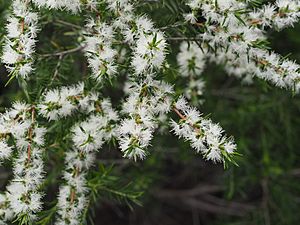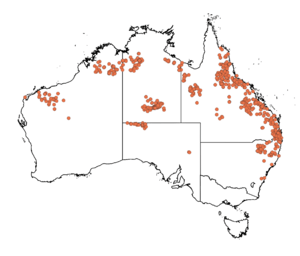Black tea-tree facts for kids
Quick facts for kids Black tea-tree |
|
|---|---|
 |
|
| Melaleuca bracteata leaves and flowers | |
| Scientific classification | |
| Genus: |
Melaleuca
|
| Species: |
bracteata
|
 |
|
| Where the Black Tea-Tree grows in Australia | |
The Black Tea-Tree, also known as the River Tea-Tree or Mock Olive, is a special plant found only in northern Australia. Its scientific name is Melaleuca bracteata. This plant belongs to the myrtle family, called Myrtaceae. It usually grows as a big bush, but if it has perfect growing conditions, it can become a tree as tall as 10 metres (about 33 feet)! People like to grow it in gardens because it can adapt to many different places. There are even special types of this plant, called cultivars, that have been created for gardening.
Contents
What Does It Look Like?
The Black Tea-Tree is a small to medium-sized tree with lots of leaves. It usually grows to be about 5 to 8 metres (16 to 26 feet) tall. It often starts to flower and make seeds when it reaches this height. The bark of the tree is rough and dark grey.
Its leaves are narrow and shaped like a spear or a line. They are about 8 to 28 millimetres (0.3 to 1.1 inches) long and 1 to 3 millimetres (0.04 to 0.12 inches) wide. The leaves don't have a stalk, or only a very short one. They grow in a spiral pattern around the stem and are packed closely together. When the leaves are young, their top surface can be a bit hairy. They also have many tiny dots that contain oil.
This tree produces many flowers! The flowers grow in loose groups, forming shapes like cylinders or ovals. These flower spikes are about 30 to 90 millimetres (1.2 to 3.5 inches) long and about 15 millimetres (0.6 inches) wide. They are usually cream or white. Each flower often has a small leaf at its base. The petals fall off soon after the flower opens. The Black Tea-Tree flowers from spring to early summer. After the flowers, small, round or barrel-shaped fruits appear. They are about 3 millimetres (0.12 inches) across and are spread out along the branches.
How It Got Its Name
The Black Tea-Tree was first officially described in 1858 by a scientist named Ferdinand von Mueller. He wrote about it in his book Fragmenta phytographiae Australiae. He found a sample of the plant near Moreton Bay in Queensland.
The second part of its scientific name, bracteata, comes from a Latin word, bractea. This word means "bract", which is a small, leaf-like part often found near a flower.
Where It Grows
You can find the Black Tea-Tree in Western Australia, the Northern Territory, and in eastern Queensland. It also grows southwards into New South Wales, reaching as far as the Macleay River.
This tree likes to grow near the coast and further inland, especially along riverbanks and in wet areas. In New South Wales, it has been seen in areas like the Northern Tablelands and the New South Wales North Coast. In Western Australia, it grows in the Kimberley and Pilbara regions. There are also some groups of these trees in South Australia that are separated from the main areas where they grow.
Is It Endangered?
Good news! The Black Tea-Tree is considered "not threatened" in Western Australia. This means it's not currently at risk of disappearing.
How People Use It
In Gardens
The Black Tea-Tree is a great choice for gardens because it can grow almost anywhere. It also has a nice, compact shape and produces many flowers. Some special types of this tree have been created for gardening, like "Revolution Gold," "Revolution Green," and a smaller version called "Golden Gem."
Traditional Uses
In the Northern Territory, Indigenous people have used this plant in traditional smoking ceremonies for medicine. They also used it to make many different things for their homes.
Special Oils
The leaves of the Black Tea-Tree contain special oils. These oils can be used to make things like insecticides (to keep bugs away), perfumes, and soap.
Gallery
-
Trunk of M. bractata growing in California.
Images for kids







